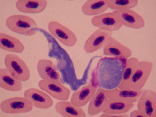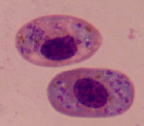|
Malaria Parasites: Ecology and Evolution
The Schall Lab at the University of Vermont |
|||
|
|
|
|
|
|
Since 1978, J. J. Schall and his students have explored the biology of malaria parasites, with studies of species that exploit reptiles and birds as their vertebrate hosts. Sites for the study of lizard malaria parasites include a long-term project at the UC Hopland Research and Extension Center, near the town of Hopland in Mendocino County California; the Long-Term Ecological Research site at El Verde in eastern Puerto Rico; and the tiny Caribbean islands of Saba and St. Martin. A major project was done years ago in Sierra Leone, west Africa. The Lesser Antilles have provided an excellent system for studies in the biogeography and phylogeography of lizard malaria in Anolis. Vermont, California, and other sites were surveyed for malaria parasites in a diverse range of avian taxa.
The first goal of the overall project was to determine the virulence of Plasmodium in lizard hosts, in which an inventory was made of the full range of pathology and reproductive costs of P. mexicanum for fence lizards at Hopland and three Plasmodium species infecting the endemic anole of Saba. Other studies pursued long-term trends in prevalence at three sites, the dynamics of natural and induced infections, transmission biology and vector ecology at Hopland, and the life history traits of the parasite, including the gametocyte sex ratio. The powerful techniques of molecular biology then opened important lines of investigation. The systematics of malaria parasites was studied, resulting in the largest molecular phylogeny ever presented, and the phylogenetic approach allowed an understanding of the biogeography of the parasites across the Caribbean islands. A set of variable genetic markers (microsatellites) for P. mexicanum were characterized, and allowed studies on the clonal diversity of infections, effect of clonal diversity on the parasite's life history and virulence, and relative proportion of clones within individual infections over time. Blood samples collected from infections for more than 40 years at Hopland are used to follow changes in the genetic makeup of the parasite over time. Also, the microsatellites allow us to score the clonal diversity within infections that opened windows into the evolution of the parasite's sex ratio. Over more recent years, the focus was switched to the wonderful gregarine parasites of earthworms (also in the same phylum as the malaria parasites). Monocystis, widely distributed in earthworm hosts, was the first protist parasite to have its complex life cycle studied, and still offers plenty of interesting questions that can be probed by old-fashioned microscope duties as well as molecular methods -- including their very own microsatellite markers. |
 This site provides details on techniques, a list of publications resulting from the studies, and photographic albums of the parasites of lizards. Information on the current lab group and previous students and their projects is also given. |
|
